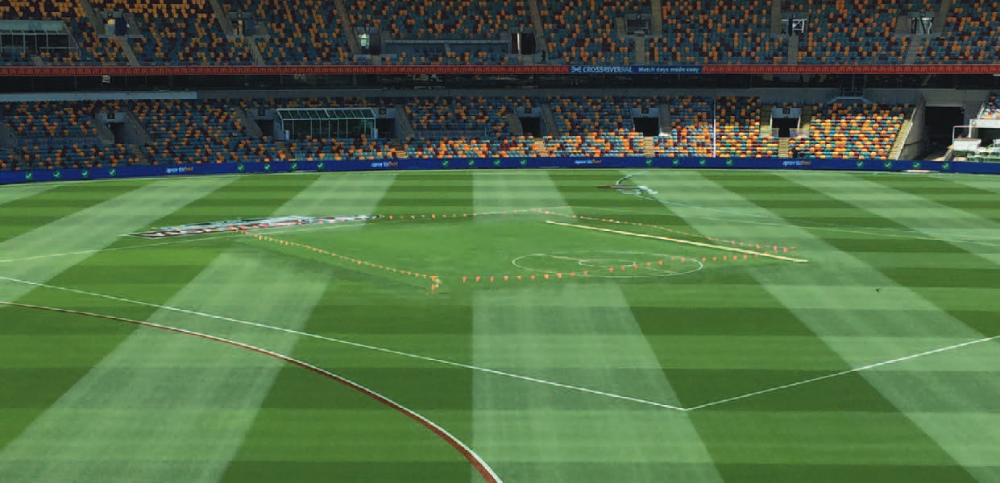How to Control Grubs In Spring
Controlling grubs is a standard issue a turf manager gears up for each spring. Not because they want to – but because they have to. This is a predictably recurrent group of pests for which running the gauntlet hoping for a season of mild pest pressure probably isn’t worth it. Population numbers do change year to year for sure but predicting which year is coming hasn’t been mastered yet so an assumption has to be made an ‘average’ year is likely. For most sites an average year would still be problematic for turf quality with no counter measures in place. We therefore treat in a proactive and pre-emptive manner.
Fortunately, a range of tools are available to mitigate the risks posed, and with good planning and the deployment of considered measures most circumstances can be safely catered for.

Anthranilic diamide or neonicitinoid
When we discuss grubs (larvae) on warm season sportsfields for spring and summer we are generally talking about the larvae of African black beetle, Argentinean scarab and billbug. For these, historically the most proven and reliable options arguably have been the neonicitinoids thiamethoxam and imidacloprid, and more recently the newer generation diamide chlorantraniliprole (sold as Acelepryn).
Of the neonicitinoids both named options will provide predictably up to 90 days of coverage or thereabouts. This is usually sufficient to cover the main window of larval activity from early September onwards. The limited window of activity however has traditionally meant timing the spring application became important in an effort to have the product in the soil prior to peak egg hatch - but not too far prior to that point to limit the window of activity post egg hatch.
Both neonicitinoids are considered quite soluble with thiamethoxam the more soluble of the two. Solubility relates to the ability of the chemistry to enter solution when moisture is available which allows the chemical to enter the grass plant and treat a pest feeding on it or in it. It is also a factor in maintaining bioavailability in the soil. There are subtle differences in sorption (soil binding) with imidacloprid having the higher potential of the two – but neonicitionoids as a family are generally considered to have low sorption.
The neonics have been well adopted courtesy of their highly selective behaviours towards insect nicotinic acetylcholine receptors (the target site on the pest), however this safety feature was actually exceeded when Chlorantranilprole was commercialized. The mammalian safety profile of this active ingredient set new benchmarks and is reflected in both the exemption from scheduling assigned to Acelepryn and the resultant lack of prescriptive PPE requirements on labels. The most impressive part of this story was not so much the excellent tox profile, but the fact no loss of efficacy had to be accepted– Infact efficacy was demonstrably enhanced particularly for longevity of performance. The improved longevity is a product of far lower solubility than the neonics, and a structural robustness that offers durability across a variety of conditions.
Scheduling options
Much like the two window strategies that are sometimes employed for pre-emergent herbicides before and after renovations, the neonics and Chlorantranilprole can work well together too. Various scheduling arrangements can be adopted to move between chemistries achieving genuine chemical rotation whilst concurrently matching shorter term needs to shorter duration products, and leaving the longer terms needs to those with greater persistence. Registered labels acknowledge this and products can have split application strategies either to cater for renovations or target two seasonal windows in spring and late summer, so long as critical annual application thresholds are not exceeded.
Note: when planning spring applications of grub control products and selecting both product to use and rates to employ the intentions around management of Lepidoptera grubs in late summer should be taken in to consideration to ensure annual limits are not inadvertently exceeded. This is a circumstance where front loading a grub control program with a neonicitinoid application before turning to a diamide application may be the most suitable sequence to achieve an extended period of coverage without a centre season weak point. Lepidoptera grubs are a strength of chlorantraniliprole but not the neonics – therefore keep this in mind at the start of the planning cycle.
Application essentials
Applications for the control of grubs in spring requires the product to be placed at the soil surface and amongst the fleshy feeder roots close to the soil surface. This is applicable for diamides and neonics alike.
If applied poorly and left high in the foliar canopy the solubility of the neonics leaves them liable to be taken in through the foliage and processed out through mowing – without ever treating a grub in the soil. These need to be irrigated immediately post application to place in the soil quickly to ensure efficacy can be optimized. Whilst not as soluble and not quite as likely to be drawn in through the leaf at quite the same rate the diamide Acelepryn should still be irrigated as soon as possible to ensure correct placement.
Best practice for achieving this placement involves 08 nozzles or flood jet nozzles, high carrier volumes such as 800L / ha, and the complementary irrigation post application.
How Nuturf can help you
Nuturf stock all products named above and are happy to speak to you about your site history and previous challenges to map out the most suitable approach for you. We can sit down with you and select a sequence of product use that suits your site, your needs and your budget. We stock the major brands and have these chemistries in multiple formulations.
Through our national network of highly competent staff we have many years of experience in treating these pests in various geographies around the country. We can therefore recognize and help plan for the nuances different locations produce.
















